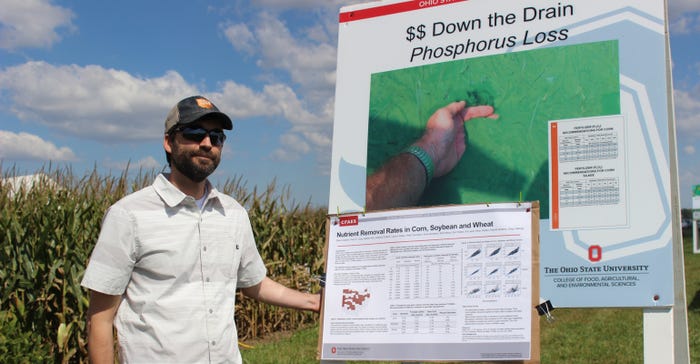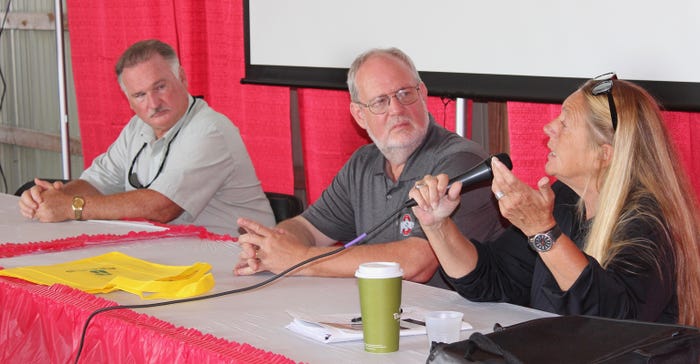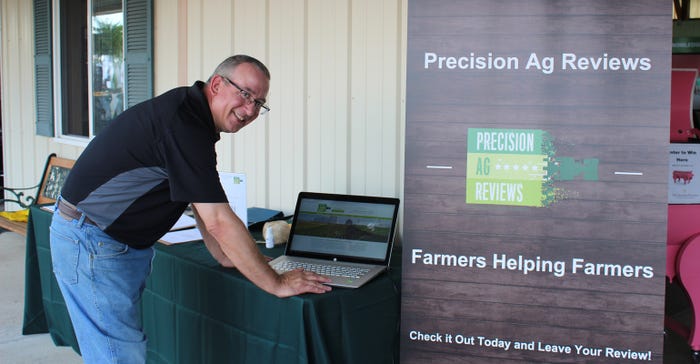
Even the most determined visitors would have been hard-pressed to stop in at each of the 636 exhibits at this year’s Farm Science Review, held Sept. 18-20. For once, the weather was dry for all three days, and the show drew more than 108,000 visitors to the Molly Caren Agricultural Center near London, Ohio. While each of the exhibitors had something to share, here are a few ideas that deserve extra attention:
Updates to fertility recommendations
For the last five years, Ohio State University researchers have been working with farmers and crop consultants to put out on-farm strip trials across Ohio to reevaluate fertilizer recommendations for corn, soybeans and wheat. Steve Cullman, state specialist in soil fertility for OSU, gave an update on the research during FSR at the agronomy plots.
The Tri-State Fertilizer Recommendations were last updated in 1995. Since then, management practices have changed and water quality concerns have increased, so recommendations are being reevaluated, Cullman explained.
One change that affects the fertility recommendations is a decrease in concentrations of potassium and phosphorus in harvested grain, Cullman said. Newer varieties have become more efficient, so farmers are removing lower levels of nutrients per bushel, although nutrient removal per acre may still be higher due to higher yields.
The research showed yield responses to additional phosphorus or potassium were very rare when the nutrients were already in or above the maintenance range (20 to 40 ppm Mehlich-3 P and 100 to 150 ppm Mehlich-3 K). If you are at maintenance levels and are applying more, there may be room for savings, Cullman explained.
For corn nitrogen recommendations, Ohio State and most other states now use an economic model, Cullman noted. Higher nitrogen rates might add a few more bushels, but, he asked, “Is that nitrogen going to pay for itself?”
To evaluate profitability, an online rate calculator is available that requires three inputs: the previous crop, N fertilizer cost and price expected for grain.
 FERTILITY UPDATES: Steve Cullman, state specialist in soil fertility for Ohio State, reviewed changes in fertility recommendations at the agronomy plots during the Farm Science Review.
FERTILITY UPDATES: Steve Cullman, state specialist in soil fertility for Ohio State, reviewed changes in fertility recommendations at the agronomy plots during the Farm Science Review.

More complete information on the updated recommendations will be available online later this year at soilfertility.osu.edu. Work with Purdue and Michigan State University researchers is ongoing to update the Tri-State Recommendations.
Agriculture’s answer to hunger
Leaders from Ohio Smart Agriculture conducted a forum during FSR to introduce the initiative and gather input on ways to strengthen Ohio agriculture while addressing problems with hunger in the state. Lisa Hamler-Fugitt, executive director of the Ohio Association of Food Banks, co-chairs the effort. She pointed out that one in seven people in Ohio struggle with hunger. “We’re 10 years out from the great recession, but you wouldn’t know it from the lines we see at our food pantries,” she said.
Those statistics were a surprise to Ohio farmer Fred Yoder when he first became involved with the Ohio Smart Agriculture project. “It’s embarrassing,” said Yoder, who co-chairs the effort. “We’re swimming in commodities and people are going hungry.”
Ohio Smart Agriculture is being funded by a grant from the W.K. Kellogg Foundation. It aims to coordinate efforts between farmers, agribusinesses, conservationists, anti-hunger advocates, public health researchers and others. The state’s struggling ag economy and hunger are related problems, explained steering committee member Bryan Snyder, who is executive director of the Initiative for Food and AgriCultural Transformation (InFACT) at Ohio State.
 SMART AG: Leaders from Ohio Smart Agriculture answered questions about their goals during the Farm Science Review. Co-chair Fred Yoder (left), steering committee member Brian Snyder and co-chair Lisa Hamler-Fugitt hope to boost profitability for farmers while restoring environmental resilience, building strong communities, engaging consumers and ensuring public health and access to nutritious food.
SMART AG: Leaders from Ohio Smart Agriculture answered questions about their goals during the Farm Science Review. Co-chair Fred Yoder (left), steering committee member Brian Snyder and co-chair Lisa Hamler-Fugitt hope to boost profitability for farmers while restoring environmental resilience, building strong communities, engaging consumers and ensuring public health and access to nutritious food.

Ohio Smart Agriculture aims to boost profitability for farmers while restoring environmental resilience, building strong communities, engaging consumers and ensuring public health and access to nutritious food, he explained. “We really have to solve all these problems at the same time.”
While many farm organizations and other groups have researched similar issues in the past, the Ohio Smart Agriculture effort is working to put research into action, building a more diverse agricultural economy that better serves the people of Ohio, Yoder added. In the past, expanding production has been the solution to problems with the ag economy, but it’s time to look for other ideas, he said. “If we’ve got all this surplus and our answer is to keep growing more, that doesn’t work.”
More about Ohio Smart Agriculture recommendations and projects is available online at ohiosmartag.net.
Reviewing precision ag tools
If you want to buy a $20 toaster, you can go online and find thousands of toaster reviews to help guide your purchase. But if you’re paying thousands on farm equipment or precision ag technology, reviews from other farmers have been hard to come by.
 REVIEWS AT THE REVIEW: Todd Tucky, project manager for Precision Ag Reviews, invited visitors at the Farm Science Review to submit their reviews of precision ag equipment and to check reviews before making purchases.
REVIEWS AT THE REVIEW: Todd Tucky, project manager for Precision Ag Reviews, invited visitors at the Farm Science Review to submit their reviews of precision ag equipment and to check reviews before making purchases.

That’s changing thanks to Precision Ag Reviews, a new online resource where farmers rate and offer feedback on the precision ag tools they use. Development of the web resource is being underwritten by the Ohio Soybean Council and reviews are being collected from across the country, explained Todd Tucky, project manager for Precision Ag Reviews.
Farmers appreciate having unbiased opinions from other farmers before they make an investment in ag technology, Tucky explained. The reviews available through the website are screened to eliminate responses that show vender bias, so farmers will have realistic information. The review site covers a variety of ag tools such as guidance systems, planting and harvesting equipment, crop monitoring tools, and hardware and software.
The value of the site relies on the willingness of farmers to share their feedback, Tucky said. “We need people to write reviews.”
To add a review or research a purchase, go to precisionagreviews.com.
High density soil testing
With automated soil testing equipment and a new soil testing lab, Integrated Ag Services is offering precise data to help clients better manage their soils and nutrients. Evan Delk, vice president of sales and marketing for Integrated Ag, explained that consistency and quality control throughout the soil sampling process gives farmers more confidence in the results they are using to make management decisions. “We’re trying to take the human error out of the process,” he said.
The independent consulting company based near Milford Center, Ohio, started automating the soil sample collection process with a prototype machine in 2011. They are now using a machine that collects 7-inch vertical slices of soil, records the latitude and longitude of each collection point, and automatically puts each sample in a bar-coded container. The company works with farmers throughout Ohio as well as in Indiana, Michigan and upstate New York.
Although the industry standard for zone sampling is 2.5-acre grids, Integrated Ag offers high-density soil sampling with grids as small as 0.25 acre. Using those high-density soil tests, farmers can develop more precise management zones. “Your confidence level on where you’re putting those inputs is much higher,” Delk said.
For more information on high density soil tests, contact Integrated Ag Services online at integratedag.net.
LAREE launch
The United Equipment Dealers Association (UEDA) is introducing the Lawn and Rural Equipment Expo (LAREE), planned for Dec. 7 and 8 at the Roberts Centre near Wilmington, Ohio.
The Ohio-Michigan Equipment Dealers Association and the Mid-America Equipment Dealers Association joined to create UEDA in 2016 in response to changes in the equipment industry. The new LAREE show is also designed to better meet the needs of today’s consumers, explained David Kahler, associate director of UEDA. Power Show Ohio, which began in 1971, had been shifting away from large agricultural equipment. The location at the state fairgrounds also had drawn complaints because of the traffic and cost of parking. UEDA decided to discontinue that show last year and focus efforts on a new show at a new location. The show will feature lawn, landscape, small farm and rural lifestyle equipment. Parking is free, and tickets are $5 with children 12 and under admitted free. For details, go to lareexpo.com.
Ration booster
Some Ohio farmers raising corn for ethanol production have been contracting to raise Enogen hybrids for several years. The specialty corn has higher levels of alpha-amylase enzymes, which help break down starches to sugar. That can be a benefit in production of ethanol, and now Syngenta is also introducing Enogen hybrids for use as feed or silage corn for dairy and beef cattle producers.
The hybrids offer production traits and yield potential comparable to other modern hybrids with the added benefit of increased feed value, explained Don Worden, sales representative with Golden Harvest. “It’s more totally digestible.” And, since cattle digest more of the starches in the corn, they produce less manure as well. Additional information is available online.
About the Author(s)
You May Also Like




